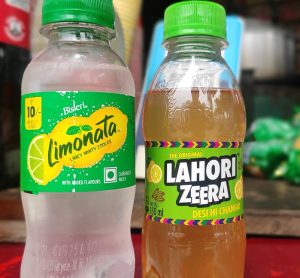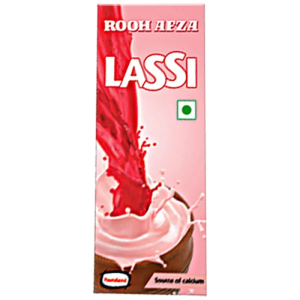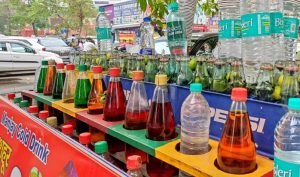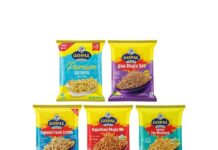
Summer in the subcontinent can be as unpredictable as the monsoon. While the lucky few get ready with travel plans to the hills, the rest of us make do with fans, air-conditioners and chilled beverages. Before the ubiquitous colas arrived, we all grew up with homemade sherbets and drinks such as RoohAfza, Rasna, Glucon-D, jaljeera, aam panna, and Tang. Many of us have a satisfying or nostalgic memory associated with one or the other.

The modern branded beverage industry has transformed lifestyles with its powerful advertising and supply chain, packaging, design, and product range — there is a commercial revival of the traditional brands. Diversification in quantity-based packaging is the most significant change enabling ease in carrying single-use plastic sachets for syrup and powder products, ready-to-drink milkshakes, and lassi in tetra packs and small bottles of fizzy drinks.
Hamdard RoohAfza
Celebrated as a refreshment drink across communities or religions, the RoohAfza sherbet is the most well-known beverage concentrate across India. The scarlet-hued syrup that is diluted with water and ice is the most common find in any Indian fridge during summer. Most of us remember holding up the 750 ml glass bottle against the light just to see its sparkling dark red hue. The RoohAfza concentrate has been around for more than a century. And with time, its packaging has also gone through changes and upgrades.
In its most recent makeover, new formats and variants have become available. It can be found in smaller bottles, a sugar-free range, sachets of 30 ml, and as readymade milkshakes and lassi in liquid aseptic cartons and as premixed carbonated beverages in pet bottles.

Formulated in 1906 in Ghaziabad, near Delhi, by Hakeem Muhammad Kabeeruddin, and introduced by Hakim Hafiz Abdul Majeed, the cooler concentrate was launched from old Delhi. Currently, RoohAfza is manufactured by Hamdard Laboratories India. Different variants by the same name are also made by Hamdard Pakistan and Hamdard Bangladesh – both separate entities. The specific Unani recipe of RoohAfza combines several ingredients popularly believed to be cooling agents, such as rose, which is used as a remedy for the hot summer winds of Northern India, Pakistan and Bangladesh – commonly known as loo.
The drink is also associated with the month of Ramadan, in which it is usually consumed during iftar. Many gurdwaras also serve this sherbet in their langars as do temples, sometimes mixed with lemonade for visitors to quench their thirst.
Powder and syrup
Rasna is another mouthwatering fond memory, from summer vacations from school times – making jugs full of the drink concentrate in ice-cold water to share with siblings and friends. The design of the product has also kept up with changing trends with variants, and innovations in its pouch formats, shapes and sizes. The instant drink mix comes in a variety of fruit-based flavors, with a new range of Haat Shikanji in a unique indigenous design. Then there are aam panna and jaljeera favors, which have a different fanbase. There are variants for instant energy and a sugar-free range whose packaging design targets fitness freaks. The pouches containing the instant powder range from packs of 1.5 kilograms to 20-gram sachets.

Squashes or fruit flavored syrup concentrates to mix in water, such as RoohAfza, although limited in their dilution with only water, also have a significant market in India and international markets. These now come in rigid plastic bottles that have undergone several changes in shape and label designs. Rasna and Kissan are considered the top producers of these concentrates in a variety of flavors and sizes ranging from bottles of 1.5 liters to 100 milliliters. Some brands have bottle sizes bigger than two liters. Concentrated drinks are not limited to RoohAfza and squash — there are other traditional concentrates such as khus and gulkand produced by Dabur, Hamdard and numerous popular Indian brands.
Beverage and businesses
RoohAfza is sold commercially as a syrup to flavor sherbets, cold milk drinks, ices, and cold desserts such as the popular falooda. The name RoohAfza is translated as ‘refresher of the soul.’ It is said that this name was coined by the original formulator of the drink, with possible cultural influences that are still prevalent and have diversified in means of consumption from place to place. In Chandni Chowk, in Delhi, a variant of this drink is served and is a must-try – ‘Mohabbat ka Sherbet’ is an ode to the summer and is loaded with milk and watermelon.

The traditional beverages are a livelihood for many vendors supplying beverages such as kokum sherbet, RoohAfza, milkshakes, lassi, lemonade, Mumbai’s famous chuski (crushed ice-candy), Delhi’s Banta and others that are sold on the Indian streets during summer. Shikanji, aam panna and jaljeera compete in a similar fashion with fizzy drinks in Rs 10 plastic bottles. Not only small-time vendors but even five-star hotels serve Roohafza and other traditionally flavored instant mix beverages as welcome drinks for their guests.
IndiFoodBev — authentic, impactful and influential
An English-language food and beverage processing and packaging industry B2B platform in print and web, IndiFoodBev is in its third year of publication. It is said that the Indian food and beverage industries represent approximately US$ 900 billion in revenues which implies more than 20% of the country’s GDP. Eliminating the wastage on the farmside can help to deliver more protein to a higher number of the population apart from generating sizable exports. The savings in soil, seeds, water, fertilizer, energy and ultimately food and nutrition could be the most immense contribution that country is poised to make to the moderation of climate change.
To improve your marketing and grow sales to the food and beverage processing and packaging industry, talk to us. Our research and consulting company IppStar [www.ippstar.org] can assess your potential and addressable markets in light of the competition. We can discuss marketing, communication, and sales strategies for market entry and growth.
Suppliers and service providers with a strategy and budget for targeted marketing can discuss using our hybrid print, web, video, and social media channels to create brand recognition linked to market relevance. Our technical writers are ready to meet you and your customers for content.
The second largest producer of fruit and vegetables in the world is continuously expanding processing capacities and delivery systems with appropriate innovative technologies. We cover product and consumer trends, nutrition, processing, research, equipment and packaging from farm to thali. Get our 2025 media kit and recalibrate your role in this dynamic market. Enhance your visibility and relevance to existing markets and turn potential customers into conversations. Ask for a sample copy of our bi-monthly in print or our weekly IndiFoodBev eZine each Wednesday.
For editorial info@ippgroup.in — for advertisement ads1@ippgroup.in and for subscriptions subscription@ippgroup.in
Naresh Khanna – 10 February 2025
Subscribe Now










